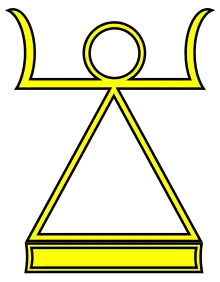Sign of Tanit
The sign of Tanit or sign of Tinnit is an anthropomorph symbol of the Punic goddess Tanit, present on many archaeological remains of the Carthaginian civilization.

The symbol has many variants, but the basic form consists of a disc on top of a triangle, separated by a horizontal line, like a schematic image of a person.
The earliest known sign of Tanit was a pendant revealed in an 11th-century BC building at Megiddo.[1] Other pendants of the sign were revealed in Ashkelon, Tel Michal, Maresha, Sidon and Motya.[2] A coin with the sign and a legend ΦΑΝΗΒΑΛΟΣ (the Phoenician title of the goddess, meaning "the face of Baal (Hammon)") was found in Ashkelon.[3][4]
The first report about the representations of the sign was in the beginning of the 19th century, on stele unearthed on the site of Carthage. Archaeological excavations have subsequently uncovered representations on other supports, such as mosaics or even on ceramics.
The excavations of tophet of Carthage, Sousse and Motya have highlighted the particularly important diffusion of the symbol in the western Mediterranean Basin, although the few discoveries on primitive Phoenician land may only be due to continued occupation of sites, making searches more difficult.[5]
Modern scholars associate the symbol with the goddess Tanit, partner of Ba'al Hammon and the most important goddess in the Punic religion. This identification is widely, but not universally, accepted. The motif may have had an apotropaic purpose, intended to offer protection from the evil eye.
The symbol is used in some contexts in modern Tunisia. For example, it has appeared on the Tanit d'or, the grand prize of the biennial Carthage Film Festival, since its establishment in 1966.[6]
Gallery
 Sign of Tanit pendants from Ashkelon
Sign of Tanit pendants from Ashkelon Stele of the necropolis of Carthage
Stele of the necropolis of Carthage Stele of the necropolis of Carthage
Stele of the necropolis of Carthage Stele of the necropolis of Carthage
Stele of the necropolis of Carthage Representation of Tanit's sign at Kerkouane
Representation of Tanit's sign at Kerkouane
.jpg.webp) Tanit's sign on Lilybaeum stele
Tanit's sign on Lilybaeum stele Tanit's sign in a Delian mosaic in the house of the dolphins
Tanit's sign in a Delian mosaic in the house of the dolphins A Modern Tanit's sign at the opening ceremony of the Carthage Film Festival 2018
A Modern Tanit's sign at the opening ceremony of the Carthage Film Festival 2018
See also
References
- Arie, Eran (2017). "The Earliest Known 'Sign of Tanit' Revealed in 11th Century BCE Building at Megiddo". Tel Aviv. 44: 61–71. doi:10.1080/03344355.2017.1280968. S2CID 134636712.
- Stern, Ian; Wolff, Samuel; Erlich, Adi (2018). "A New Tanit Pendant from Maresha". Eretz-Israel: Archaeological, Historical and Geographical Studies (in Hebrew). 33: 232. ISSN 0071-108X. JSTOR 26751870.
- Yadin, Y. (1967). "Symbols of Deities at Zinjirli, Carthage and Hazor". Yediot Bahaqirat Eretz-Israel Weatiqoteha (in Hebrew). 31 (1/4): 53. ISSN 2312-0061. JSTOR 23734250.
- Hill, George Francis (1914). Catalogue of the Greek coins of Palestine. London. p. LIX.
{{cite book}}: CS1 maint: location missing publisher (link) - Lipinski, Edward (1992). Dictionnaire de la civilization phénicienne et punique. Brepols. ISBN 2503500331.
- IMDb, awards